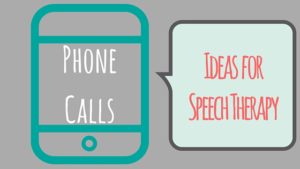Phone calls can be a great therapy task, because almost every adult wants to be able to talk on the phone! For adults that feel hesitant about returning to that skill, I practice “low pressure” real-life phone calls in therapy. “Low Pressure” means the person on the other end of the phone will never know the speaker if it doesn’t go well! Today I’m sharing key questions to make this task person-centered, how to use this activity to target a therapy goal, and a list of low-pressure phone call ideas.
 Phone Calls + Person-Centered Care:
Phone Calls + Person-Centered Care:
In order to be sure this therapy activity is person-centered, here are some questions you could ask to decide what types of phone calls to practice:
- “What phone calls do you need to make in your day-to-day life?”
- “Do you have any phone calls to make that we could use today in therapy, to target *** (goal)?”
- “Are there some phone calls you could make this week that would be a good home program assignment for you?”
- “Is everything going okay when you make or answer a phone call? Is there anything you hope to improve?”
Low-Pressure Phone Call Ideas:
If possible, have the person you are working with come up with local names of stores, people, or businesses that they may call in their day-to-day week. Personalize any of these “to-do” items to be real to-do items for the person you are working with. Here are some ideas of calls to use in therapy or as a home assignment:
- Call 2 local dry-cleaning professionals and determine the best spot to take dress pants for dry cleaning.
- Call your local library and find out the hours they are open on Tuesdays.
- Call your local post office and explain that you need to mail a textbook. Do they have all the supplies needed to package this and then send it in the mail?
- Call a bank in your area and ask the requirements to start a savings account through them.
- Call a home improvement store and ask about the types of options they have for roof shingles.
- Find a kennel in your area and determine the price and requirements.
- You are planning to add some mulch to your backyard. Call a garden store (or 2!) and determine price and types of mulch options they offer.
- Call your insurance to determine your therapy benefit.
- Call a local food delivery restaurant and order.
- Call your doctor’s office to clarify a medication dosage or appointment time.
Sample Therapy Ideas:
I hope these ideas are useful or help you easily target a person-centered goal! If you would like other ideas like this, please check out my Home Sweet Home Series.
| To Target Strategies or Skills in This Area: | The Patient Could Do This: |
| Verbal Expression | *Use word-finding strategies with new or unfamiliar listeners
*Participate in unscripted dialogue *Practice script training with new listeners |
| Written Expression | *Write out/script phone conversation or questions to assist with organizing information |
| Auditory Comprehension | *Rapid listening and following instructions for phone tree navigation
*Comprehend new information over 5-minute phone call *Use of breakdown/repair strategies |
| Reading Comprehension | *Locate appropriate phone number and read correctly to dial correctly |
| Motor Speech | *Challenge ability to carry-over motor speech strategy or skill over phone call environment |
| Attention | *Sustain attention: Listen to phone tree options and navigate successfully. Sustain attention for xx minutes of phone call conversation.
*Divide attention: Write notes about phone call information while talking on the phone |
| Memory | *Short-term recall for new information gained from phone call |
| Thought Organization | *Organize list of questions or comments to include in conversation, to improve efficiency and outcome |
| Problem-Solving / Reasoning | *Know how to repair conversation if not heard, understood, or if mis-understood
*Generate appropriate follow-up questions to ask in conversation
|
| Executive Function | *Evaluate strategy success during task, or plan how to adapt strategies for new situation.
*Plan home program task that could be a similar challenge |
| Pragmatics | *Use appropriate social language for a verbal task (Adjust tone or vocabulary based on talking to peer vs place of business).
*Use appropriate turn taking. |
What other low-pressure phone calls have you used in speech therapy?
If you want more ideas of how to make your therapy person-centered, check out the Home Sweet Home Series and Functional Toolbox posts (Garden Seed Packets, Tool Kit).
Make sure you get the latest functional therapy updates: “Like” Honeycomb Speech Therapy on Facebook or Pinterest, or sign up for email updates.
Why not written and thought organization too? I have my patients write out their phone call so they present their ideas sequentially and clearly. And it goes along with thought organization because they have to again organize what they want to say especially if it’s a business call, a call to a doctor, etc. and that all leads to clearer verbal expression to convey their message. Just my interpretation. Nice ideas. I’ve talked to you before. I love your ideas. I looked up TED Talks for Kids- I have a 10 y/o concussed patient!! I found a few. Most are too long but there’s a really cool one about sea animals that’s only about 5 minutes.
I love the written expression and thought organization idea, Nanette! I will have to update the post to share as an idea! Thank you!